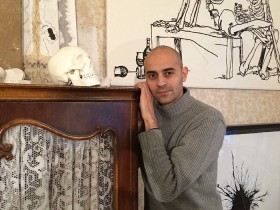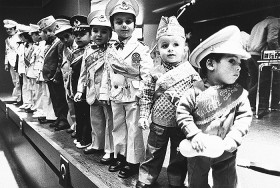Purim is a family celebration, a time when children dress up, make a great din with rattles and gorge themselves on traditional Haman sweetmeats. By so much merriment it seems a little astonishing to recall that this religious holiday is actually rooted in a Bible story that is anything but happy and G-rated.

King Ahasuerus falls in love with Esther © photo: Shlomit Tulgan
The Book of Esther, which is read on Purim, tells of how the orphan girl Esther carries out a spectacular operation to rescue the Jewish people from the hands of King Ahasuerus, ruler of the Kingdom of Persia. The anonymous author recounts this story in the style of an epic poem and thereby suggests that God plays only a minor role in the proceedings. He turns the spotlight instead on the cunning with which clever Esther and her Uncle Mordechai manage to stop vizier Haman from realizing the pogrom he has planned against the Persian Jews. → continue reading

Victor Alaluf in his studio in Berlin-Friedrichshain © Jewish Museum Berlin, photo: Denis Grünemeier
A retro-style armoire with a skull sitting on top of it—a piece from the collection of Victor Alaluf, an artist with Argentinian roots whom I interviewed recently in his studio in Berlin-Friedrichshain.
In his work—installations, mainly, comprised of drawings, collage, sculpture, video art and everyday objects—Alaluf addresses the existential issues raised by our experience of death, pain, and the ephemeral and fragile nature of all living creatures. His choice both of material and objects is decisive. He frequently chooses brittle materials, such as glass or ceramics, as well as organic matter, such as human hair and blood. Alaluf has a particular penchant for → continue reading
In some families the subject of circumcision provokes intense discussion, as you can see in the films that are part of our special exhibition “Snip it! Stances on Ritual Circumcision”. Oliwia is familiar with this difficult situation: on the one hand her Muslim husband considers it a natural part of the tradition, and on the other, particularly her Catholic father argues vehemently against it. Should she have her four-year-old son circumcised? What does she think of the practice herself? We spoke about these questions with Oliwia, as well as about her final decision.
Oliwia*, what different factors affected your family’s conflict over whether to circumcise your son?

“Boys before their Circumcision”, photo from the series “Turkish in the Ruhr district”, Cologne, 1983 © Henning Christoph / Soul of Africa Museum
My husband is Moroccan and Muslim. My background is Roman Catholic, although I converted to Islam in 2006. We had a son four years ago and from the beginning it was clear for my husband that Jamal would be circumcised. It’s a part of the tradition for him and it symbolizes a man’s identification with Islam.
It wasn’t so clear for you?
No. Actually, I’m → continue reading


